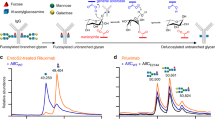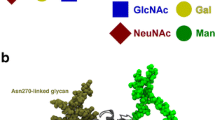Abstract
The effect of deglycosylation on the physiological and functional organization of milin was studied under different denaturizing conditions. Trifluoromethanesulfonic acid mediated deglycosylation resulted in insoluble milin, which was found to be soluble only in 1.5 M GuHCl with native-like folded structure. Kinetic stability, proteolytic activity, and dimeric association were lost in deglycosylated milin. Urea-induced unfolding revealed two inactive, highly stable equilibrium intermediates at pH 7.0 and pH 2.0. These intermediates were stable between 5.5–6.5 and 5.0–6.0 M total chaotropes (urea + 1.5 M GuHCl) at pH 7.0 and pH 2.0, respectively. GuHCl-induced unfolding was cooperative and noncoincidental with a broad transition range (2.0–5.0 M) at pH 7.0 and pH 2.0. Equilibrium unfolding of deglycosylated milin by urea and GuHCl substantiates the involvement of various inactive monomeric intermediates. This study provides a way to understand the role of glycosylation in the unfolding mechanism, stability, and functional activity of the serine protease milin.





Similar content being viewed by others
Abbreviations
- GuHCl:
-
Guanidine hydrochloride
- TFMS:
-
Trifluoromethanesulfonic acid
- UV:
-
Ultraviolet
- CD:
-
Circular dichroism
- ANS:
-
1-Anilino-8-naphthalene sulfonic acid
References
Apiyo D, Jones K, Guidry J, Wittung-Stafshede P (2001) Equilibrium unfolding of dimeric desulfoferrodoxin involves a monomeric intermediate: iron cofactors dissociate after polypeptide unfolding. Biochemistry 40:4940–4948
Bernard BA, Newton SA, Olden K (1983) Effect of size and location of the oligosaccharide chain on protease degradation of bovine pancreatic ribonuclease. J Biol Chem 258:12198–12202
Bosques CJ, Tschampel SM, Woods RJ, Imperiali B (2004) Effects of glycosylation on peptide conformation: a synergistic experimental and computational study. J Am Chem Soc 126:8421–8425
Cassim JY, Yang JT (1969) A computerized calibration of the circular dichrometer. Biochemistry 8:1947–1951
Cupo JF, Allen RA, Jesaitis AJ, Bokoch GM (1989) Reconstitution and characterization of the human neutrophil N-formyl peptide receptor and GTP binding proteins in phospholipid vesicles. Biochim Biophys Acta 982:31–40
Curtis MA, Thickett A, Slaney JM, Rangarajan M, Aduse-Opoku J, Shepherd P, Paramonov N, Hounsell EF (1999) Variable carbohydrate modifications to the catalytic chains of the RgpA and RgpB proteases of Porphyromonas gingivalis W50. Infect Immun 67:3816–3823
Daniels R, Kurowski B, Johnson AE, Hebert DN (2003) N-linked glycans direct the cotranslational folding pathway of influenza hemagglutinin. Mol Cell 11:79–90
Edge AS (2003) Deglycosylation of glycoproteins with trifluoromethanesulphonic acid: elucidation of molecular structure and function. Biochem J 376:339–350
Gagneux P, Varki A (1999) Evolutionary considerations in relating oligosaccharide diversity to biological function. Glycobiology 9:747–755
Grafl R, Lang K, Vogl H, Schmid FX (1987) The mechanism of folding of pancreatic ribonucleases is independent of the presence of covalently linked carbohydrate. J Biol Chem 262:10624–10629
Halfman CJ, Nishida T (1971) Nature of the alteration of the fluorescence spectrum of bovine serum albumin produced by the binding of dodecyl sulfate. Biochim Biophys Acta 243:294–303
Hirsch C, Misaghi S, Blom D, Pacold ME, Ploegh HL (2004) Yeast N-glycanase distinguishes between native and non-native glycoproteins. EMBO Rep 5:201–206
Imperiali B, O’Connor SE (1999) Effect of N-linked glycosylation on glycopeptide and glycoprotein structure. Curr Opin Chem Biol 3:643–649
Kuster B, Krogh TN, Mortz E, Harvey DJ (2001) Glycosylation analysis of gel-separated proteins. Proteomics 1:350–361
Lynn KR, Clevette-Radford NA (1988) Proteases of euphorbiaceae. Phytochemistry 27:45–50
Malech HL, Gardner JP, Heiman DF, Rosenzweig SA (1985) Asparagine-linked oligosaccharides on formyl peptide chemotactic receptors of human phagocytic cells. J Biol Chem 260:2509–2514
O’Conner SE, Imperiali B (1998) A molecular basis for glycosylation-induced conformational switching. Chem Biol 5:427–437
O’Connor SE, Imperiali B (1996) Modulation of protein structure and function by asparagine-linked glycosylation. Chem Biol 3:803–812
Pace CN, Shirley BA, McNutt M, Gajiwala K (1996) Forces contributing to the conformational stability of proteins. Faseb J 10:75–83
Petrescu SM, Branza-Nichita N, Negroiu G, Petrescu AJ, Dwek RA (2000) Tyrosinase and glycoprotein folding: roles of chaperones that recognize glycans. Biochemistry 39:5229–5237
Quehenberger O, Prossnitz ER, Cochrane CG, Ye RD (1992) Absence of G(i) proteins in the Sf9 insect cell. Characterization of the uncoupled recombinant N-formyl peptide receptor. J Biol Chem 267:19757–19760
Reuter G, Gabius HJ (1999) Eukaryotic glycosylation: whim of nature or multipurpose tool? Cell Mol Life Sci 55:368–422
Shental-Bechor D, Levy Y (2008) Effect of glycosylation on protein folding: a close look at thermodynamic stabilization. Proc Natl Acad Sci U S A 105:8256–8261
Soulages JL, Pennington J, Bendavid O, Wells MA (1998) Role of glycosylation in the lipid-binding activity of the exchangeable apolipoprotein, apolipophorin-III. Biochem Biophys Res Commun 243:372–376
Stryer L (1965) The interaction of a naphthalene dye with apomyoglobin and apohemoglobin. A fluorescent probe of non-polar binding sites. J Mol Biol 13:482–495
Varki A (1993) Biological roles of oligosaccharides: all of the theories are correct. Glycobiology 3:97–130
Wenzel-Seifert K, Seifert R (2003) Critical role of N-terminal N-glycosylation for proper folding of the human formyl peptide receptor. Biochem Biophys Res Commun 301:693–698
Wenzel-Seifert K, Hurt CM, Seifert R (1998) High constitutive activity of the human formyl peptide receptor. J Biol Chem 273:24181–24189
Wujek P, Kida E, Walus M, Wisniewski KE, Golabek AA (2004) N-glycosylation is crucial for folding, trafficking, and stability of human tripeptidyl-peptidase I. J Biol Chem 279:12827–12839
Xia K, Manning M, Hesham H, Lin Q, Bystroff C, Colon W (2007) Identifying the subproteome of kinetically stable proteins via diagonal 2D SDS/PAGE. Proc Natl Acad Sci U S A 104:17329–17334
Yadav SC, Jagannadham MV (2009) Complete conformational stability of kinetically stable dimeric serine protease milin against pH, temperature, urea, and proteolysis. Eur Biophys J 39:981–991
Yadav SC, Pande M, Jagannadham MV (2006) Highly stable glycosylated serine protease from the medicinal plant Euphorbia milii. Phytochemistry 67:1414–1426
Yadav SC, Jagannadham MV, Kundu S (2009) A kinetically stable plant subtilase with unique peptide mass fingerprints and dimerization properties. Biophys Chem 139:13–23
Yadav SC, Kundu S, Jaganadham MV (2010) Equilibrium unfolding of kinetically stable serine protease milin: presence of various active and inactive dimeric intermediates. Eur Biophys J (in press)
Acknowledgments
Financial assistance to S.C.Y. from the Council of Scientific and Industrial Research (CSIR) Government of India, in the form of a research fellowship and the financial assistance from UGC and DBT, Government of India, for infrastructure are acknowledged.
Author information
Authors and Affiliations
Corresponding authors
Rights and permissions
About this article
Cite this article
Yadav, S.C., Prasanna Kumari, N.K. & Jagannadham, M.V. Deglycosylated milin unfolds via inactive monomeric intermediates. Eur Biophys J 39, 1581–1588 (2010). https://doi.org/10.1007/s00249-010-0615-x
Received:
Revised:
Accepted:
Published:
Issue Date:
DOI: https://doi.org/10.1007/s00249-010-0615-x




